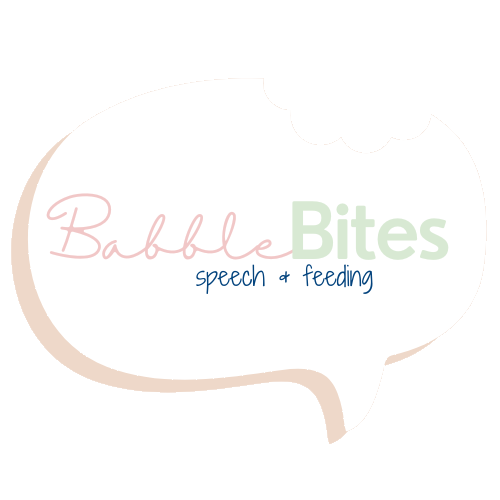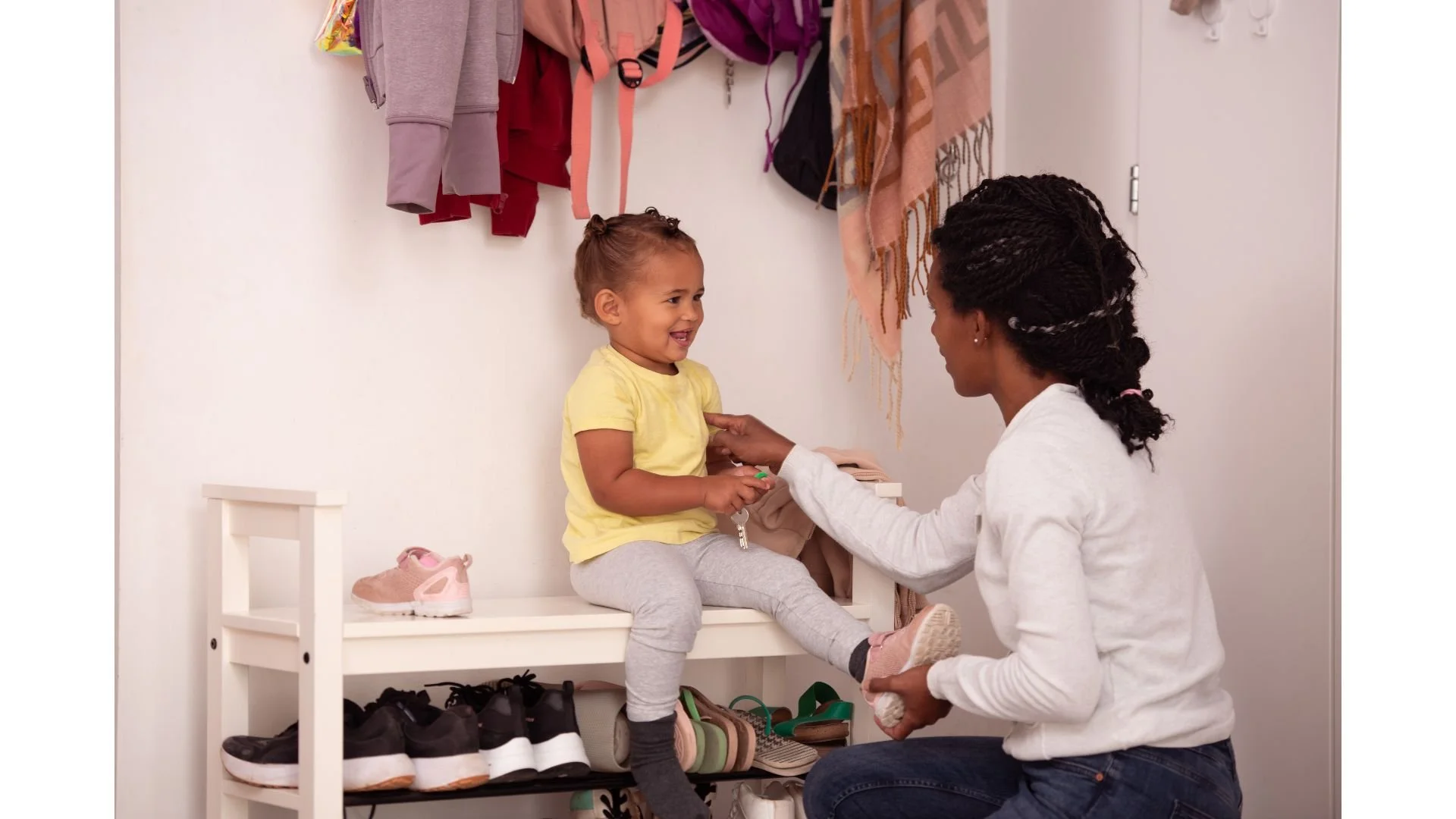Quick Tips for Parents to Help Your Baby Say Their First Words
When trying to figure out how to help their baby learn to say their first words, many parents are told “talk to your baby” and “read more books.” While this is not technically bad advice, there are more intentional strategies that parents can use to work towards their children learning to talk. Here are my top tips and strategies, as a speech-language pathologist, for parents to use to help their baby work towards saying their first words.
Narrate your day
Self-talk and parallel-talk, or narration, consist of describing what you and your little one are doing throughout the day. This provides a language-rich environment needed for language development, especially for children with delayed language.
Self-talk is when you describe what you are doing.
This includes what you are seeing, smelling, feeling, tasting, and doing. For example:
Getting dressed: “I’m putting your socks on, one foot, two feet. Time for shoes, I’m putting your shoes on. On your feet.”
Snack time: “Let’s open the refrigerator. I see your yogurt. I got your spoon. Let’s pick you up and put you in your chair, time to eat yogurt. I opened your yogurt and I can smell the blueberries.”
Bed time: “Time for bed, let’s pick out a book. Time to turn the lights off. Lights off. It’s nice and dark. Good night bear, good night dada, good night [child].”
Parallel-Talk is when you describe what your child is doing.
This includes describing what your child is seeing, smelling, feeling, tasting, and doing. For example:
Breakfast time: “You’re scooping your oatmeal. You’re chewing your strawberry, mmm so juicy. It looks like you want more strawberries.”
Play time: “You got the ball. You pushed it down the ramp, weee go ball! It’s the car’s turn to go down. You found the red car.”
At the park: “Look at you climbing those stairs! Up up up! You chose the yellow slide, you’re at the top of the slide! Weee you’re sliding down! That was fast!”
Narrate what you see and what you’re doing while at the grocery store: “You got the apple, it’s yellow and red. Let’s put it in the bag, in bag. You put the apple in the bag.”
Narration works best when it’s intentional. This does not mean you have to have a constant stream of narration throughout the entire day. By finding opportunities to add language by talking to your child, during everyday meaningful routines, we are providing them with the vocabulary to help understand and navigate their environment, and work towards communicating with those first words. In order for children to learn to use words, they need to hear them used many many times in context, and self-talk and parallel-talk are fantastic ways to provide those language learning opportunities in a natural way.
Hold objects up near your mouth as you label them
This helps your baby focus on the movement of your mouth as you say the word. They are more likely to look up at your mouth while you say the word if you are holding the object they are interested in right next to your mouth. You can say the word in an exaggerated way, by stretching out the vowels and making the consonants pronounced. You can even point to your mouth as you say the word. For example, try holding their favorite toys up near your mouth while you label it before handing it to them, such as “ball,” “car,” “baby,” “book,” or “block.”
Vary your tone of voice
Research has found using parentese, or infant-directed speech, which is when adults use a sing-songy rhythm with higher-pitched tone of voice, helps bring your baby’s attention to your voice. This then increases their attention to the words you are saying, making it easier for your child to learn new words because they are paying closer attention to the words, which is necessary in order to start using words. Not only does using parentese increase your baby’s attention to the words because they sound more interesting, adults are also more likely to create an emotional connection by using facial expressions and gestures while using parentese, which helps further pique your baby’s interest in the words you are saying. Learn more about using parentese here.
Use verbal routines
Verbal routines are phrases and sentences you say every time you’re doing a routine action during the day with your child, and is a simple and effective early language strategy to help increase your baby’s understanding of and use of words in meaningful contexts. Daily routines include meal times, washing hands, getting dressed, turning the lights on/off, getting in the car, going for walks, playing with toys, cleaning up, walking up and down stairs, folding laundry, getting ready for daycare, getting ready for bed… anything you do as part of your daily routine! Verbal routines come in when we say the same phrase or sentence each time we do that routine, such as, “shoes on,” “get soap, wash hands” “lights on,” “up, up, up stairs,” “night-night puppy,” and “bye-bye bus.”
Use verbal routines during daily routine tasks like putting on shoes. “Shoe on foot, shoe on foot.”
Verbal routines let your child hear words repeatedly in a meaningful context, or contextual repetition. Children need to hear a new word many times before they are able to understand it, and then use it themselves. When your child hears you say the same thing each time you do a routine task, the language they hear becomes expected, and they are eventually able to start saying the verbal routine, or part of the routine, on their own. Learn more about verbal routines here.
Imitate your baby’s sounds
Imitating your baby encourages them to vocalize more, as they are getting a response from you. By imitating your baby, you are also teaching them the concept of imitation, which is needed in order to say their first words. For example, if your baby says, “ba,” make eye contact with your baby and imitate it back by saying, “ba.” Pause and look at your baby expectantly (smile, mouth open, eyebrows raised), and wait to see if your baby repeats it back again, or continues to vocalize. Your baby will be more likely to imitate you if you frequently imitate them, and it will only be a matter of time until they start to imitate words instead of just sounds! Babies typically imitate words before they start using them independently for different functions.
Model statements more than asking questions
When we’re trying to get our babies to talk, we may find ourselves constantly quizzing them: “What’s this called?” “What’s that called?” “What color is this?” “What does a dog say?” “What do you want?” “What is this?” The problem is, when we are asking question after question that our child is not able to answer, we’re not providing them with the words, or verbal models, that they need in order to answer the questions. Additionally, when we continuously ask our child questions that they are not able to answer, it can be really frustrating for them. Instead, use strategies described above like narration and verbal routines, which provides your child with verbal models of statements (i.e. comments, not questions), which will provide them with the language they need to eventually answer questions. Once your baby is starting to use several words, stick to the 3 Statements to 1 Question Ratio strategy.
Wondering how many words your toddler should be saying? Check it out here.
What should I do if I’m concerned about my baby’s language development?
If your child has not yet met the milestones for their age, or has just met the number of words milestone and is not making steady gains, in addition to implementing early language strategies, reach out to your pediatrician for a referral to a speech-language pathologist. If you are concerned about your child’s speech and language development, it’s important to get an evaluation with a speech-language pathologist. Early intervention has been proven to have better outcomes than the outdated “wait and see” approach, so speak to your pediatrician if you are concerned. Every state has a state-funded early intervention program, although these programs can be difficult to qualify for. If you are still concerned, you can reach out to a private practice in your area.
Learn about how to encourage pre-linguistic skills by clicking here, which can help support your baby learning to say their first words.
Follow us on Instagram for “bite-sized” information on language strategies:
This website and information on this blog post is provided for educational purposes only. It is not meant as medical advice, intended to replace a speech-language assessment, therapy from a speech-language pathologist, or serve as medical care for a child. It is recommended that you discuss any concerns or questions you might have with your speech-language pathologist, pediatrician, and medical team, and develop an individualized team plan specifically for your child.
Click below to pin this post to Pinterest to save for later and share!



